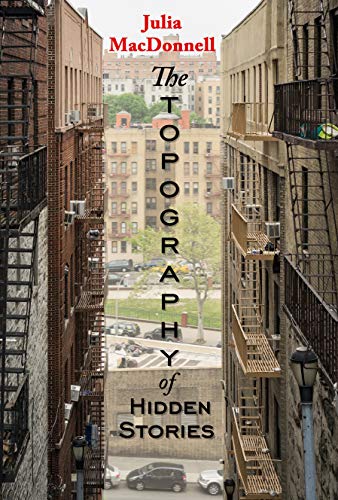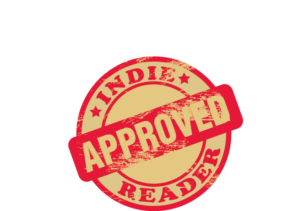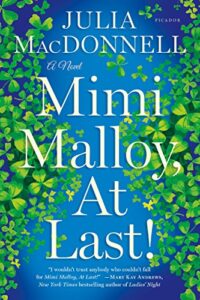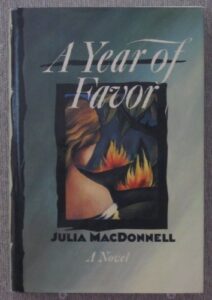The Topography of Hidden Stories received a 4+ star review, making it an IndieReader Approved title.
Following find an interview with author Julia MacDonnell.
What is the name of the book and when was it published?
The Topography of Hidden Stories published by Fomite Press, January 2021.
What’s the book’s first line?
Ma was going to find the river –that’s what she told me as the two of us drove north through the Adirondack Mountains in Daddy’s Pontiac.
What’s the book about? Give us the “pitch”.
The Topography of Hidden Stories is a collection of short stories, most of them about characters grappling with doubt and disquiet in their search for love and connection. Taken together they create a tapestry of women’s lives in the late 20th and early 21st centuries. Several feature women trapped in a pious patriarchy that has yet to loosen its control of women’s lives, especially their creative power and fertility. However difficult their situations, these characters confront experience with sharp eyes, ironic wit and heart.
What inspired you to write the book? A particular person? An event?
Given that this is a collection of stories rather than one long narrative, I had many different inspirations over the course of several years, often when I was working on something else. Some stories were based on events in the news; some were seeded by stories I heard friends tell; and others were triggered by events and experiences in my large, conflicted Scots-Irish Catholic family.
What’s the main reason someone should really read this book?
People should read my book to get a unique and compelling perspective on some ordinary events in the lives of families and the universal struggle of smart creative young women to come of age in the post-war years. They should read Topography because the various stories offer glimpses of hope in the darkest circumstances, and also because I have worked so hard to develop myself as a writer, focusing for many years on my sentences and my use of language, trying to make every sentence both true and resonant. The writing in these stories represents my most authentic writing self.
What’s the most distinctive thing about the main character? Who-real or fictional-would you say the character reminds you of?
Again, no main character because this is a story collection. However, the protagonists of these stories tend to long for love and understanding, and they are always probing for the meaning of their own experiences and yearning to make life better for themselves and those around them.
If they made your book into a movie, who would you like to see play the main character(s)?
Topography offers many stories. Hence, many actors would have to star – and all of them would have to be tall, slender and gorgeous!!
When did you first decide to become an author?
I never decided to become an author. Because of my family’s reverence for education and the written word (most especially via my paternal grandfather Angus, an autodidact and newspaperman) it seems inevitable that I would have become a writer. However I explored many other forms of creative self-expression before I devoted myself to writing. Among them were dancing, acting, and various forms of music. All of these other artistic explorations have provided wonderful material for my work. I think I would have preferred to be a painter but I had, much to my chagrin, no gift for it.
Is this the first book you’ve written?
This is my third published book. I’ve had two novels published by major publishers: Mimi Malloy, At Last! by Picador and A Year of Favor by William Morrow.
What do you do for work when you’re not writing?
Lucky me – I am finally retired after a quarter of a century teaching journalism and creative writing at the graduate and undergraduate levels at a public university in southern New Jersey. Now I am also an empty nester after raising three children. Even with the pandemic, retirement has been a glorious time for me to focus on my literary writing and the stories that mean the most to me.
How much time do you generally spend on your writing?
I write most days for between three and six hours depending upon what else I have to do. This is a new thing for me since I worked fulltime, and parented fulltime, during the writing of my two novels. Included in my writing time these days are reading, research and journaling, all of which are important parts of my process. When I’m not actually at the desk, I’m usually thinking about writing… pondering sentences, reworking them in my head.
What’s the best and the hardest part of being an indie?
The best thing about being an indie author is that the published work is entirely your own vision without any interference from an overarching ‘corporate’ structure. Hence, the work represents your own truest voice. As I’ve already said, I had two novels published by major publishers and both were amazing experiences. I am forever grateful for those experiences. But the publication of The Topography of Hidden Stories has been more creatively satisfying and more intimate, a truly gratifying experience. These stories are my own in the deepest possible way.
The worst thing about the Indies grows from that same creative latitude: the writer, in many ways, works without a net! No copyeditors or proofreaders to rely on. No marketing budget or planned publicity campaign. All of that is a DIY deal for the writer, and you’ve got to be quite entrepreneurial to make it work.
What’s a great piece of advice that you can share with fellow indie authors?
Believe in yourself and persist. Those trite, over-used words fail to capture how damned hard it is to write a book and get it published in any format. You’ve got to be really tough to endure it. By the time publication happens, the writer has no doubt been through an obstacle course of self-doubt and rejection!! Only the strong survive.
Would you go traditional if a publisher came calling? If so, why?
I have published two novels with major publishers. Both were dreams come true: extraordinary experiences in my growth and development as a writer. Both novels were agented but my agent had no interest at all in representing my short stories as she felt they had no commercial possibilities.
All of these stories had been published in little magazines, and two had been nominated for Pushcart Prizes. I thought they deserved to be read by more people, and also to be read as a group, which creates a kind of synergy among them.
I’m so glad I made the decision to go ‘indie.’ I’ve been thrilled and delighted with Fomite Press! Couldn’t be more appreciative of them for the work we’ve done together.
Is there something in particular that motivates you (fame? fortune?)
What motivates me now and has always motivated me as a creative person is the desire to make a meaning out of my own life and the lives of my loved ones. I have never written for either fame or fortune, and that’s a good thing because I haven’t gotten either one!! What I’ve gotten instead is a body of work I am really at peace with even if I don’t ever make it to the bestseller lists.
Which writer, living or dead, do you most admire?
So many!! So many great writers, so little time!! In no particular order and for many varied reasons, and at various times in my own development, my writing superstars are or have been: Alice Munro, Ross Macdonald, Russell Banks, Robert Penn Warren, Toni Morrison, Eudora Welty, Ernest Hemingway, Gabriel Garcia Marquez, Gregory Orr, Adrienne Rich, Joan Didion, Masha Gessen, Lesley Jamison, Steve Almond, Jonathan Franzen and Deborah Levy.
Which book do you wish you could have written?
Interestingly, and perhaps ironically, all the books I wish I’d written are nonfiction narratives by women: Beyond the Beautiful Forevers, by Katherine Boo; The Immortal Life of Henrietta Lacks, by Rebecca Skloot; Five Days at Memorial, by Sherry Fink; Random Family by Adrian Nicole LeBlanc; and Enrique’s Journey by Sonia Nazario. I am in awe of these authors probing minds, narrative skills, and courage. How I’d love to be able to do what they have done!!
I’d also like to give a shout out to Louise DeSalvo whose memoirs and writing about writing: The Art of Slow Writing; Writing as a Way of Healing; The House of Early Sorrows and On Moving have provided me with both ballast and inspiration during the long and often lonely years of working at my craft.



